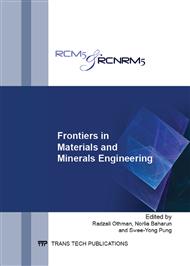p.32
p.40
p.46
p.52
p.56
p.60
p.67
p.74
p.80
Effect of the Sponge Used as the Template for the Production of Porous Cordierite
Abstract:
Cordierite (2MgO.2Al2O3.5SiO2) is widely used in high temperature applications due to its high melting temperature and high resistance to thermal, chemical and corrosion shock. The use of various structure of cordierite especially porous structure became more popular where its properties can be tailored by controlling the open and closed porosity, cell size distribution and cell morphology. In this study, porous cordierite was synthesized using sol-gel method followed by replication of polymeric sponge method using three different types of polymeric sponge (Type A, B and C). Immersed sponge were then sintered at 1300°C to determine better sponge types to produce porous cordierite. Sponge was characterized using FTIR and porous sample produced were characterized using Scanning Electron Microscope (SEM) and density and porosity testing.
Info:
Periodical:
Pages:
56-59
Citation:
Online since:
November 2013
Authors:
Keywords:
Price:
Сopyright:
© 2014 Trans Tech Publications Ltd. All Rights Reserved
Share:
Citation:


